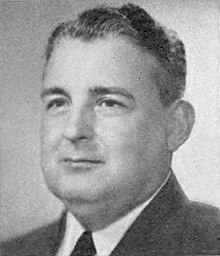William M. Tuck
| William M. Tuck | |
|---|---|
 |
|
| Member of the U.S. House of Representatives from Virginia's 5th district |
|
|
In office April 14, 1953 – January 3, 1969 |
|
| Preceded by | Thomas B. Stanley |
| Succeeded by | Dan Daniel |
| 55th Governor of Virginia | |
|
In office January 16, 1946 – January 18, 1950 |
|
| Lieutenant | Lewis Preston Collins II |
| Preceded by | Colgate Darden |
| Succeeded by | John S. Battle |
| 25th Lieutenant Governor of Virginia | |
|
In office January 21, 1942 – January 16, 1946 |
|
| Governor | Colgate Darden |
| Preceded by | Saxon Winston Holt |
| Succeeded by | Lewis Preston Collins II |
| Member of the Virginia Senate from the 10th district |
|
|
In office January 13, 1932 – January 14, 1942 |
|
| Preceded by | James Stone Easley |
| Succeeded by | James D. Hagood |
| Member of the Virginia House of Delegates from Halifax County | |
|
In office January 9, 1924 – January 13, 1932 Alongside John Glass, Samuel Adams and A. Owen King |
|
| Preceded by | Daniel W. Owen |
| Succeeded by | Roy B. Davis |
| Personal details | |
| Born |
William Munford Tuck September 28, 1896 Halifax, Virginia, U.S. |
| Died | June 9, 1983 (aged 86) South Boston, Virginia, U.S. |
| Political party | Democratic |
| Spouse(s) | Eva Ellis Lovelace Dillard |
| Alma mater |
College of William & Mary Washington & Lee University |
| Profession | Attorney |
| Religion | Presbyterian |
| Military service | |
| Allegiance |
|
| Service/branch | United States Marine Corps |
| Years of service | 1918–1919 |
| Battles/wars | World War I |
William Munford Tuck (September 28, 1896 – June 9, 1983) was a Virginia lawyer and lieutenant in the Byrd Organization, who served as the 55th Governor of Virginia from 1946 to 1950 as a Democrat, and as a U.S. Congressman from 1953 until 1969.
He was the youngest of nine children of Halifax County, Virginia tobacco warehouseman Robert James Tuck(1863-1930) and Virginia Susan Fitts (1860-1909). He was named for his grandfather William Munford Tuck (1832-1899), who served in the Third Virginia Infantry during the American Civil War. Tuck's mother died when he was 13. He attended county schools, Virgilina High School, and Chatham Training School (now Hargrave Military Academy). He attended the College of William and Mary for two years, earning a teacher's certificate and working for a year as a teacher/principal in Northumberland County. Tuck then enlisted in the U.S. Marine Corps and served in 1917 in the Caribbean. Tuck returned to attend law school at the Washington and Lee University School of Law, graduating in 1921. In 1929 he married widow (and former schoolteacher) Eva Lovelace Dillard (1891-1975), to whom he remained married until her death in 1975, raising her son Lester Layne (L.L.) Dillard Jr. as his own.
Upon being admitted to Virginia bar, Tuck maintained a private legal practice in Halifax for decades, eventually with his stepson L.L. Dillard.
His career as an elected official began in 1923, when Halifax County voters elected Tuck as their delegate (a part-time position) to the Virginia General Assembly. He was re-elected once but declined to run for re-election in 1929, citing the need to grow his legal business to support his new family. However, when his elected successor died, Tuck was drafted in 1930 and served the remainder of the term. He was then elected to the Virginia State Senate in 1931, where he became a friend of U.S. Senator Harry F. Byrd, a former governor. During the national New Deal, state Senator Tuck worked to repeal Prohibition and sponsored new child labor laws, as well as an unemployment compensation system, old age assistance and jail reforms. He also helped develop the state park system.
...
Wikipedia
